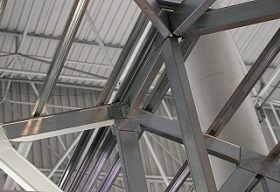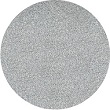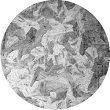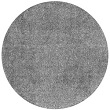Galvanized
- Home
- /
- Homepage
- /
- Flat Steel
- /
- Galvanized
Ínico do conteúdo da página
Overview
Hot Dip Galvanizing is one of the most effective and economic processes used to protect steel against atmospheric corrosion. The protection of steel by the zinc coating occurs according to two mechanisms: by the barrier protection, possible due to the coating layer, and galvanic sacrificial protection, in the case of simultaneous exposure of the steel-zinc pair for in small discontinuities of the coating. Another important feature of the zinc coating is its ability to bond metallurgically to the base steel by means of an intermetallic alloy layer, thereby forming a fully integrated system. This product can be produced with the same or different zinc coating per side. The thicker the coating, the greater the durability of the plate. Zinc coatings are classified into: pure zinc with regular spangle (GI) and minimized spangle (GI), and zinc-iron alloy (GA).



Types of Coating
Pure Zn – Minimized Spangle

Surface Appearance
This terminology, minimized spangle, it is applied to the pure Zn coating. It is produced from a Zn bath with or without addition of spangles forming elements and has a bright appearance. In the case of the bath with addition of spangles forming elements, a fast solidification process is required by the action of a coolant. This type of coating is most recommended for applications mainly to painting in the automotive and household appliances (home appliances). It can also be used in the construction industry for specific applications.
Pure Zn – Regular Spangle

Surface Appearance
This kind of Zinc coating is obtained by normal solidification of the deposited layer, resulting in a surface with visible zinc spangles with flowers appearance. This surface is indicated for general applications, especially for the construction industry such as roofing, closures, structural profiles and others.
Pure Zn – Available Coatings to Example of Standard
| Standard | Coating Designation | Coating Mass (g/m 2) | |
| Single-Spot Test | Triple-Spot Test | ||
| NBR7008/12 | |||
| Z100 | 85 | 100 | |
| Z120 | 100 | 120 | |
| Z140 | 120 | 140 | |
| Z180 | 150 | 180 | |
| Z225 | 195 | 225 | |
| Z275 | 235 | 275 | |
| Z350 | 300 | 350 | |
| Z450 | 385 | 450 | |
| Z600 | 510 | 600 | |
Zinc-Iron Alloy – Galvannealed

Surface Appearance
This kind of coating is obtained by sheet heating after the deposition of zinc which completely transforms the Zn coating in Zn-Fe alloy layer. This layer contains about 8 to 12% of Fe, and has a matte gray surface appearance. The presence of Fe in the coating improves the resistance spot welding behavior and paint adhesion. Therefore is mainly used in the automotive industry.
Galvannealed- Available Coatings to Example of Standard
| Standard | Coating Designation | Coating Mass (g/m 2) | |
| Single-Spot Test | Triple-Spot Test | ||
| NBR7008/12 | ZF100 | 85 | 100 |
| ZF120 | 100 | 120 | |
| ZF140 | 120 | 140 | |
| ZF180 | 150 | 180 | |
Structural
Product Description
Structural steels are generally carbon manganese steels where the high mechanical strength is obtained by a solid solution associated with thermo-mechanical processing conditions. This steel is mainly indicated for flat uses and applications that requires light drawing, simple bendings and corrugations.
Examples of application: Structural profiles, storage silos and structures in general.
Available Dimensions and Examples of Standard Requirements
| Thickness Min (mm) |
Thickness Max (mm) |
Width Min (mm) |
Width Max (mm) |
| 0.5 | 3.0 | 700 | 1500 |
The combination of thickness x width depends on the grade of the standard and the coating characteristics.
| Technical Standard | Grade | Mechanical Properties (transverse direction) | ||||
| YS (MPa) Min. |
TS (MPa) Min. |
Elongation | ||||
| Thickn. (mm) |
Gauge Length | Value (%) |
||||
| (mm) | Min. | |||||
| NBR7008-3/12 | ZAR-230 | 230 | 310 | Any | 50 | 22 |
| ZAR-250 | 250 | 360 | 17 | |||
| ZAR-280 | 280 | 380 | 16 | |||
| ZAR-320 | 320 | 390 | 14 | |||
| ZAR-345 | 345 | 430 | 12 | |||
| ZAR-400 | 400 | 450 | 10 | |||
| ZAR-550 | 550 | 570 | – | |||
| Technical Standard | Grade | Mechanical Properties (longitudinal direction) | ||||
| YS (MPa) Min. |
TS (MPa) Min. |
Elongation | ||||
| Thickn. mm |
Gauge Length mm |
Value Min. (%) |
||||
| EN 10346/2009 | S220GD | 220 | 300 | Any | 80 | 20 |
| S250GD | 250 | 330 | 19 | |||
| S280GD | 280 | 360 | 18 | |||
| S320GD | 320 | 390 | 17 | |||
| S350GD | 350 | 420 | 16 | |||
| S550GD | 550 | 560 | – | |||
Bake Hardening
Product Description
Bake hardening steels (BH) increase its mechanical strength by the aging phenomena during the painting process in the automotive industry. These steels combine mechanical strength and formability and can be used in exposed panels such as hoods, and roofs (because it has greater resistance to indentation) or structural parts. The good formability is ensured by the low initial values of yield strength. After the drawing and painting of the parts, the yield strength increases, reaching the mechanical strength similar to that of high strength steels.
Examples of application: In the case of lower strength class, exposed automobile parts such as hoods, roofs and door panels. For the classes of higher strength, internal parts in the body structure.
Available Dimensions and Examples of Standard Requirements
| Thickness Min (mm) |
Thickness Max (mm) |
Width Min (mm) |
Width Max (mm) |
| 0.46 | 0.59 | 800 | 1230 |
| 0.6 | 2.5 | 800 | 1555 |
The combination of thickness x width depends on the grade of the standard and the coating characteristics.
| Technical Standard | Grade | Mechanical Properties (transverse direction) | |||||||||
| YS (MPa) min |
YS (MPa) max |
TS (MPa) min |
TS (MPa) max |
BH Index (MPa) min |
r90 min |
n90 min |
Elongation | ||||
| Thickn. (mm) |
Gauge Length (mm) |
Value min (%) |
|||||||||
| NBR7008-4/12 | ZARBH180 | 180 | 260 | 300 | 380 | 30 | 1.5 | 0.16 | Any | 50 | 34 |
| ZARBH210 | 210 | 300 | 320 | 400 | 30 | 1.2 | 0.15 | 32 | |||
| ZARBH240 | 240 | 320 | 350 | 440 | 30 | 1.4 | 0.16 | 31 | |||
| ZARBH270 | 270 | 340 | 340 | 440 | 30 | – | – | 28 | |||
| ZARBH300 | 300 | 380 | 380 | 500 | 30 | – | – | 26 | |||
| Technical Standard | Grade | Mechanical Properties (transverse direction) | |||||||||
| YS (MPa) min |
YS (MPa) max |
TS (MPa) min |
TS (MPa) max |
BH Index (MPa) min |
r90 min |
n90 min |
Elongation | ||||
| Thickn. (mm) |
Gauge Length (mm) |
Value min (%) |
|||||||||
| EN 10346/2009 | HX180BD | 180 | 240 | 290 | 360 | 35 | 1.5 | 0.16 | Any | 80 | 34 |
| HX220BD | 220 | 280 | 320 | 400 | 35 | 1.2 | 0.15 | 32 | |||
| HX260BD | 260 | 320 | 360 | 440 | 35 | – | – | 28 | |||
| HX300BD | 300 | 360 | 400 | 480 | 35 | – | – | 26 | |||
| HX340BD | 340 | 400 | 440 | 520 | 35 | – | – | 24 | |||
High Strength and Low Alloy
Product Description
These are low-carbon steels generally containing additions of niobium, titanium and / or vanadium in order to increase the mechanical strength through the precipitation and grain refinement processes. These steels can also have solid solution hardening elements such as Mn, P and Si. The HSLA steels combine high mechanical strength, good energy absorption capacity and good weldability, properties required to perform well in the automotive industry.
Examples of application: Reinforcement applications such as structural parts
Available Dimensions and Examples of Standard Requirements
| Thickness Min (mm) |
Thickness Max (mm) |
Width Min (mm) |
Width Max (mm) |
| 0.46 | 2.50 | 700 | 1500 |
The combination of thickness x width depends on the grade of the standard and the coating characteristics.
| Technical Standard | Grade | Mechanical Properties (transverse direction) | ||||||
| YS (MPa) min |
YS (MPa) max |
TS (MPa) min |
TS (MPa) max |
Elongation | ||||
| Thickness (mm) |
Gauge Length (mm) |
Value (%) min |
||||||
| NBR7008-6/12 | ZARBL260 | 260 | 360 | 340 | 460 | Any | 50 | 26 |
| ZARBL300 | 300 | 400 | 380 | 500 | 23 | |||
| ZARBL340 | 340 | 440 | 400 | 540 | 21 | |||
| ZARBL380 | 380 | 500 | 440 | 580 | 19 | |||
| ZARBL420 | 420 | 540 | 460 | 620 | 17 | |||
| ZARBL460 | 460 | 580 | 500 | 670 | 15 | |||
| Technical Standard | Grade | Mechanical Properties (transverse direction) | ||||||
| YS (MPa) min |
YS (MPa) max |
TS (MPa) min |
TS (MPa) max |
Elongation | ||||
| Thickness (mm) |
Gauge Length (mm) |
Value min (%) |
||||||
| EN 10346/2009 | HX260LAD | 260 | 330 | 350 | 430 | Any | 80 | 26 |
| HX300LAD | 300 | 380 | 380 | 480 | 23 | |||
| HX340LAD | 340 | 420 | 410 | 510 | 21 | |||
| HX380LAD | 380 | 480 | 440 | 560 | 19 | |||
| HX420LAD | 420 | 520 | 470 | 590 | 17 | |||
| HX460LAD | 460 | 560 | 500 | 640 | 15 | |||
| HX500LAD | 500 | 620 | 530 | 690 | 13 | |||
Advanced High Strength Steels
Product Description
The advanced high strength steels (AHSS) are high strength steels obtained by means of high cooling rates from the austenitic field, in hot rolling, or from the two-phase field (ferrite + austenite) in annealing. These steels are used in vehicles parts that require high impact energy absorption such as bumpers and front and rear spars and high impact resistance such as columns and beams that are part of form the vehicle survival cell. The classification of these steels is according to the tensile strength as a function of its microstructure: dual phase (DP) steels, complex phase (CP) steels, ferritic-bainitic (FB) steels, martensitic steels (MS), transformation induced plasticity (TRIP) steels, twinning induced plasticity (TWIP) steels and press hardening steels (PHS). The use is in accordance with the application and the particular characteristics of each type of steel.
Examples of application: In the automotive industry, in structural parts (beams, crossbeams and others).
Available Dimensions and Examples of Standard Requirements
| Thickness Min (mm) |
Thickness Max (mm) |
Width Min (mm) |
Width Max (mm) |
| 0.70 | 1.96 | 851 | 1300 |
The combination of thickness x width depends on the grade of the standard and the coating characteristics.
| Technical Standard | Grade | Mechanical Properties (longitudinal direction) | |||||||
| YS (MPa) min |
YS (MPa) max |
TS (MPa) min |
BH Index (MPa) min |
Elongation | n90(10-20%) | ||||
| Thickn. (mm) |
Gauge Length (mm) |
Value (%) min |
|||||||
| NBR16284/14 | DPLZ600 | 340 | 440 | 30 | Any | 80 | 20 | 0.14 | |
| Technical Standard | Grade | Mechanical Properties (transverse direction) | |||||||
| YS (MPa) min |
YS (MPa) max |
TS (MPa) min |
BH Index (MPa) min |
Elongation | n(10- UE) | ||||
| Thickn. (mm) |
Gauge Length (mm) |
Value (%) min |
|||||||
| EN 10346/2009 | HCT600X | 340 | 420 | 600 | 30 | Any | 80 | 20 | 0.14 |
DP600 Table by Euronorm.
High Strength IF
Product Description
High Strength Interstitial Free steels (IF-HSS) are steels that combine mechanical strength and good formability. These steels have a high mechanical strength by addition of alloying hardeners elements by solid solution such as P, Mn and Si.
Examples of Application: The IF-HS steels of low strength have been replacing conventional IF steels in applications such as exposed panels (e.g. doors), and the IF-HS steels of higher strength are used in structural parts.
Available Dimensions and Examples of Standard Requirements
| Thickness Min (mm) |
Thickness Max (mm) |
Width Min (mm) |
Width Max (mm) |
| 0.56 | 1.8 | 800 | 1400 |
The combination of thickness x width depends on the grade of the standard and the coating characteristics.
| Technical Standard | Grade | Mechanical Properties (transverse direction) | ||||||||
| YS (MPa) min |
YS (MPa) max |
TS (MPa) min |
TS (MPa) max |
Elongation | r90 | n90 | ||||
| Thickn. (mm) |
Av. Base Gauge Length |
Value (%) |
Value | Value | ||||||
| (mm) | min | min | min | |||||||
| NBR7008-3/12 | ZARIF160 | 160 | 240 | 270 | 350 | Any | 50 | 36 | 1.8 | 0.19 |
| ZARIF180 | 180 | 260 | 320 | 400 | 34 | 1.7 | 0.18 | |||
| ZARIF210 | 210 | 300 | 340 | 420 | 32 | 1.5 | 0.17 | |||
| ZARIF240 | 240 | 320 | 350 | 440 | 31 | 1.4 | 0.16 | |||
| ZARIF270 | 270 | 340 | 360 | 460 | 30 | 1.3 | 0.16 | |||
| Technical Standard | Grade | Mechanical Properties (transverse direction) | ||||||||
| YS (MPa) min |
YS (MPa) max |
TS (MPa) min |
TS (MPa) max |
Elongation | r90 | n90 | ||||
| Thickn. (mm) |
Gauge Length | Value (%) |
Value | Value | ||||||
| (mm) | min | min | min | |||||||
| EN 10346/2009 | HX160YD | 160 | 220 | 300 | 360 | Any | 80 | 37 | 1.9 | 0.2 |
| HX180YD | 180 | 240 | 330 | 390 | 34 | 1.7 | 0.18 | |||
| HX220YD | 220 | 280 | 340 | 420 | 32 | 1.5 | 0.17 | |||
| HX260YD | 260 | 320 | 380 | 440 | 30 | 1.4 | 0.16 | |||
| HX300YD | 300 | 360 | 390 | 470 | 27 | 1.3 | 0.15 | |||
Mild Steels
Product Description
The steels with drawing requirement are steels, with alloy concepts of low carbon (drawing quality) and ultra low carbon IF – Interstitial Free (from deep to extra deep drawing quality), for applications where is required critical forming levels for the, production of the parts used in more complex drawing processes.
Examples of application: In the home appliances are used in refrigerators, washers and microwaves and, depending on the drawing level required, in applications such as gussets, doors, internal cavities and supports. In the automotive industry, these steels are used in exposed and internal panels such as doors, hoods and roofs and some structural parts.
Examples of Standard Requirements
| Technical Standard | Grade | Mechanical Properties (transverse direction) | ||||||||||||||||
| YS (MPa) min |
YS (MPa) max |
TS (MPa) max |
Elongation | r90 Value min | n90 Value min | |||||||||||||
| Thickn. (mm) |
Gauge Length (mm) |
Value Min. (%) |
||||||||||||||||
| NBR7008-2/12 | ZE | 140 | 300 | 420 | Any | 50 | 26 | – | – | |||||||||
| ZEE- Grade 1 | 140 | 260 | 380 | 31 | – | – | ||||||||||||
| ZEE- Grade 2 | 140 | 220 | 350 | 37 | 1.60 | 0.18 | ||||||||||||
| ZEE- Grade 3 | 140 | 200 | 350 | 40 | 1.90 | 0.21 | ||||||||||||
| ZEE- Grade 4 | 120 | 180 | 350 | 40 | 1.90 | 0.21 | ||||||||||||
| Technical Standard | Grade | Mechanical Properties (transverse direction) | |||||||||||||||||
| YS (MPa) min |
YS (MPa) max |
TS (MPa) min |
TS (MPa) max |
Elongation | r90 | n90 | |||||||||||||
| Thickn. (mm) |
Gauge Length | Value (%) |
Value | Value | |||||||||||||||
| (mm) | min | Min. | Min. | ||||||||||||||||
| EN 10346/2009 | DX52 | 140 | 300 | 270 | 420 | Any | 80 | 26 | – | – | |||||||||
| DX53 | 140 | 260 | 270 | 380 | 30 | – | – | ||||||||||||
| DX54 | 120 | 220 | 260 | 350 | 36 | 1.6 | 0.18 | ||||||||||||
| DX56 | 120 | 180 | 260 | 350 | 39 | 1.9 | 0.21 | ||||||||||||
| DX57 | 120 | 170 | 260 | 350 | 41 | 2.1 | 0.22 | ||||||||||||
Commercial Quality
Product Description
The steels classified as commercial quality are steels with simple alloy design, for applications where is required minor critical forming levels for the production of the parts where is used bending, roll forming and light stamping processes.
Examples of application: In the home appliances, are used in washers, refrigerators, stoves and microwaves, in applications such as cabinets, gussets, doors and reinforcements in general. These steels are also used in construction industry, mainly on roofing and side covering.
Available Dimensions and Examples of Standard Requirements
| Thickness Min (mm) |
Thickness Max (mm) |
Width Min (mm) |
Width Max (mm) |
| 0.30 | 3.0 | 700 | 1555 |
The combination of thickness x width depends on the Grade of the standard and the coating characteristics.
| Technical Standard | Grade | Mechanical Properties (transverse direction) | |||||||
| YS (MPa) min |
YS (MPa) max |
TS (MPa) max |
Elongation | r90 Value min |
n90 Value min |
||||
| Thickn. (mm) |
Gauge Length (mm) |
Value Min. (%) |
|||||||
| NBR7008-2/12 | ZC | – | – | Any | 50 | – | – | – | |
 Contraste
Contraste